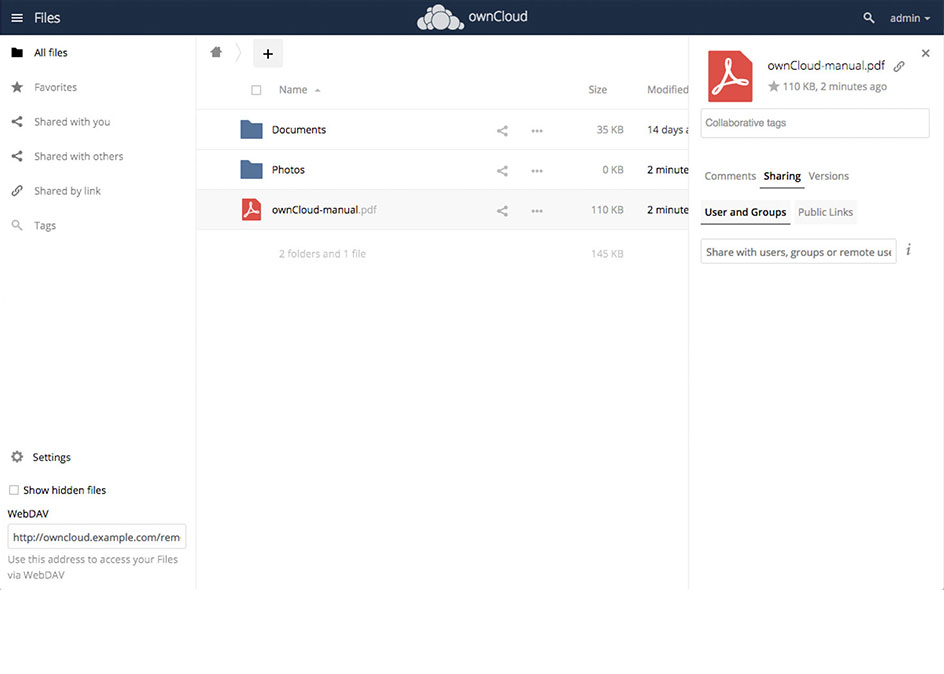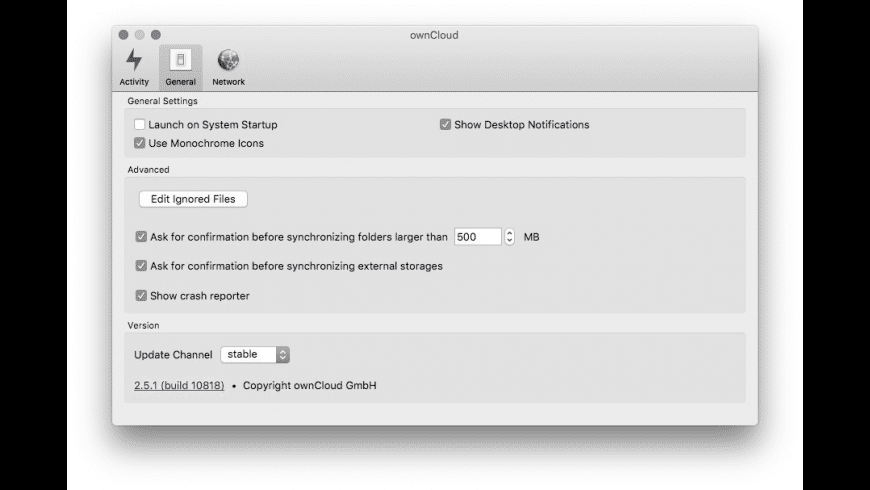The ownCloud macOS client software allows you to set up bi-directional file synchronisation between the Edinburgh DataSync service and a particular folder on the local Mac.
Sync and collaborate on your desktop or laptop. The Nextcloud desktop client keeps photos and documents always up to date, enabling you to work like you always did. Any file you add, modify or delete in the synced folders on your desktop or laptop will show up, change or disappear on the server and all other connected devices. Bitnami ownCloud Stack Virtual Machines Bitnami Virtual Machines contain a minimal Linux operating system with ownCloud installed and configured. Using the Bitnami Virtual Machine image requires hypervisor software such as VMware Player or VirtualBox. Both of these hypervisors are available free of charge. QOwnNotes is the open source (GPL) plain-text file markdown note taking application for GNU/Linux, Mac OS X and Windows by Patrizio Bekerle (pbek on GitHub and IRC), that (optionally) works together with the notes application of ownCloud or Nextcloud. Download owncloud 5.0.11 for Mac from our software library for free. Our built-in antivirus checked this Mac download and rated it as 100% safe. Owncloud-5.0.11.tar.bz2 or owncloud-4.0.2.tar.bz2 are the frequent file names to indicate this program's installer. Get started with ownCloud, your secure cloud solution for filesharing. Install on your server or sign-up for our online service. 14-day free trial!
Download
To download the client, navigate to the following URL and, under the 'ownCloud desktop client' section in the Table of contents, click on the 'Mac OS' link for the macOS client. This will take you to the Download link for the latest ownCloud installer package for OSX, which you can then double-click and follow the instructions to install.
Configure
- On your Mac, navigate to your home folder with the house icon. This is your main folder in your account on the machine and is found either at Macintosh HD > Users > username, or in the ‘Favorites’ on the left-hand-side of your Finder window.
- When in your home folder, click on the ‘File’ menu and choose ‘New Folder’ and give the folder the exact same name as the one you set up using the DataSync web interface instructions.
- From the Applications folder on your Mac, launch the ‘owncloud.app’ application and you should see the Connection Wizard window.
- Enter the server address as https://datasync.ed.ac.uk and press ‘Next’.
- Put in your DataSync username and password and press ‘Next’.
- Leave the option 'Synchronise everything from server' checked, click the button next to 'Local Folder', select the folder you created earlier in your home folder in the Finder. Press ‘Connect’, then ‘Finish’.
- ownCloud should now connect and you should see that the ownCloud menu icon at the top of the screen has either a blue synching icon in it, denoting it is in the process of synching your files, or a green tick denoting that it has successfully synched them.
Need any help?
You can download the latest version of the ownCloud Desktop SynchronizationClient from the ownCloud Website.There are clients for Linux, Mac OS X, and Microsoft Windows.
Installation on Mac OS X and Windows is the same as for any softwareapplication: download the program and then double-click it to launch theinstallation, and then follow the installation wizard. After it is installed andconfigured the sync client will automatically keep itself updated; seeThe Automatic Updater for more information.
Linux users must follow the instructions on the download page to add theappropriate repository for their Linux distribution, install the signing key,and then use their package managers to install the desktop sync client. Linuxusers will also update their sync clients via package manager, and the clientwill display a notification when an update is available.
Linux users must also have a password manager enabled, such as GNOME Keyring orKWallet, so that the sync client can login automatically.

Improvements and New Features¶

The 1.8 client has a number of enhancements and performance improvements,including:
- Graphical selective sync file and folder selector. Select which files andfolders to sync with just a few clicks.
- Selective sync on account setup. Set up which files and folders you want tosync when you create a new ownCloud account.
- File manager integration: share files from Windows Explorer, Mac OS X Finder,and Nautilus on Linux.
- Faster uploads and downloads.

Note
When you upgrade from 1.7, restart Windows to ensure that all newfeatures are visible.
Installation¶
Owncloud Desktop Client Download
The installation wizard takes you step-by-step through configuration options andaccount setup. These examples are on Windows 7; note the new “Integration forWindows Explorer Option”. This allows Windows users to share files directlyfrom their local ownCloud folder in Windows Explorer, rather than having toopen a Web browser and share from the ownCloud Web interface. Mac users get thesame option for Finder, and Linux users for Nautilus.
The next screen selects the installation folder for the client. The default isfine; don’t change this without a good reason.
In the next screen, enter your ownCloud server URL.
Owncloud Download Server
If your ownCloud server has a self-signed SSL certificate, you will see a scarywarning. Check “Trust this certificate” and keep going.
On the next screen enter your ownCloud login and password.
Now you can select while folders and files to sync, and the location of yourlocal ownCloud folder.
When you check “Choose what to sync” it opens a file picker. Note the warningat the top that unchecked folders will be removed from your local filesystem.On a new installation, when you have not yet synced with your ownCloud server,no files will be deleted.
In the next screen you may click to open ownCloud in a Web browser, or openyour local ownCloud folder. Open your local ownCloud folder so you can see howfile manager integration works.
When you are in your local ownCloud folder you can right-click any file orfolder, and then left-click “Share with ownCloud” to create a share link. Note that Windowsmay also have a Share With option. This is not the ownCloud Share option. TheownCloud share dialog looks like the following example:
You have the same options for creating a link share as you do when you’relogged into the ownCloud Web GUI: you may optionally set a password andexpiration date.
You may change your sync options at any time by opening your ownCloud clientand clicking the “Choose what to sync” button. This opens the same file pickeryou saw in the installation wizard. If you un-check any folders or files thatyou have already synchronized they will be deleted.

Right-click on the systray icon to see more options, such as Open ownCloud inbrowser, Open folder ‘ownCloud’, Recent changes, Help, and Quit ownCloud.




